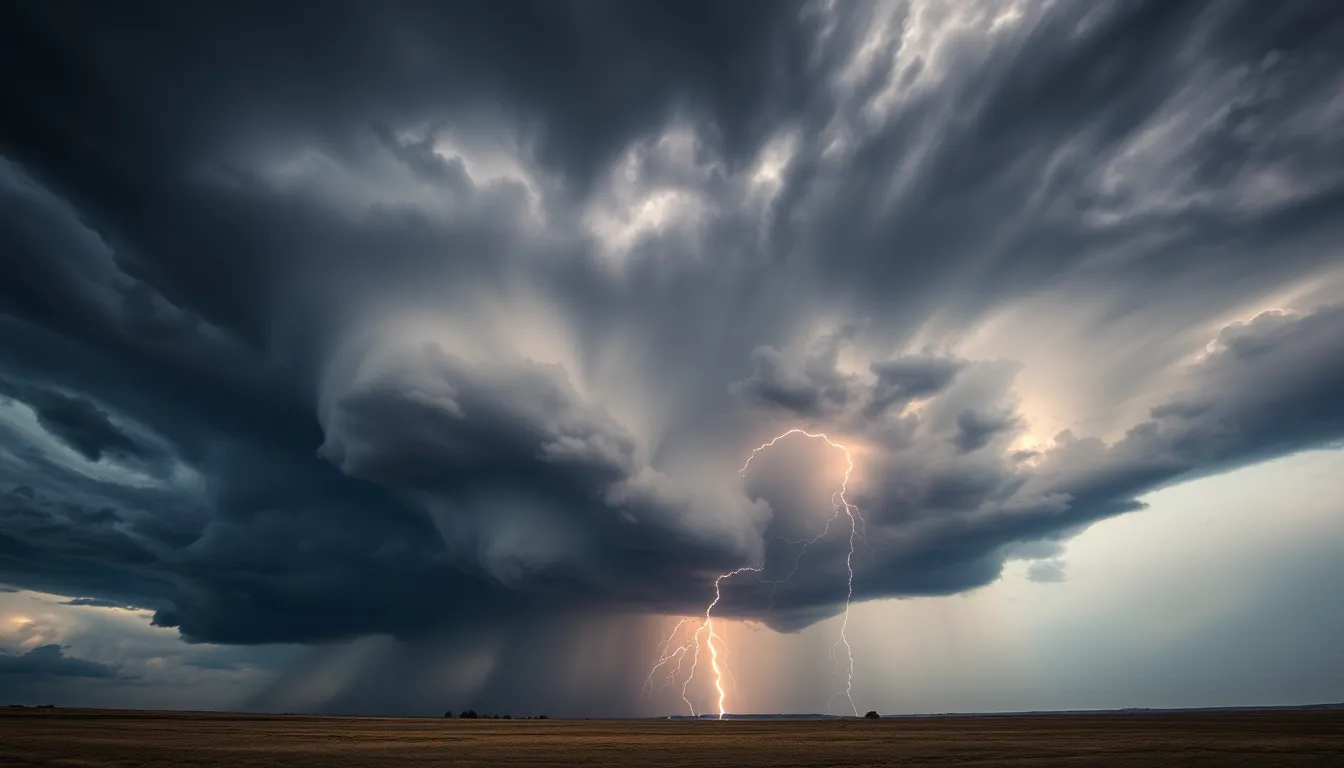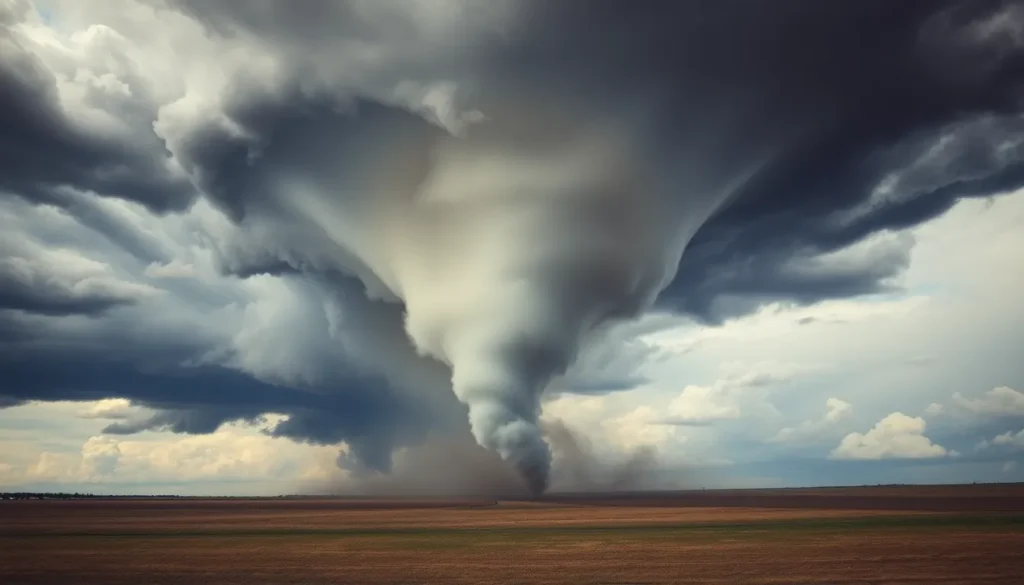Tornadoes might seem like nature’s way of throwing a wild party, but understanding how they form is no laughing matter. These swirling columns of destruction can appear out of nowhere, leaving behind a trail of chaos. But fear not! It’s not all doom and gloom; there’s a fascinating science behind their creation that’s worth exploring.
Table of Contents
ToggleUnderstanding Tornado Formation
Tornado formation involves a complex interplay of atmospheric conditions. Key factors contribute to the development of these intense storms.
The Role of Wind Shear
Wind shear plays a crucial role in tornado development. It refers to the change in wind speed and direction at different altitudes. As warm, moist air rises and meets cold, dry air, wind shear can create rotating updrafts. These rotating updrafts are essential for funnel cloud formation. Storms with significant wind shear experience greater instability, which increases the likelihood of tornado formation. Observing wind patterns provides insight into potential tornado activity.
Conditions for Tornado Development
Certain conditions favor tornado formation. Warm, moist air at the surface combines with cooler, drier air in the upper atmosphere, creating strong instability. This instability prompts the formation of supercell thunderstorms. Supercells feature a well-defined rotating updraft known as a mesocyclone. High wind speeds at various altitudes support the development of a tornado. When all these conditions align, the potential for tornadic activity rises significantly. Understanding these prerequisites helps meteorologists predict occurrences and issue timely warnings.
Stages of Tornado Formation

Tornado formation occurs through a series of specific stages. Understanding each step clarifies how these destructive events arise from atmospheric conditions.
Initial Thunderstorm Development
Thunderstrikes and intense winds characterize the initial stage of thunderstorm development. Warm, moist air rises into the atmosphere, creating instability. This warm air often encounters a layer of cooler air above, leading to the formation of cumulonimbus clouds. Updrafts form as warm air continues to ascend rapidly. Eventually, this process can trigger the development of severe thunderstorms, setting the stage for tornadoes.
Supercell Formation
Supercells represent a powerful type of thunderstorm capable of producing tornadoes. These formations require a unique combination of wind shear and atmospheric moisture. Rotating updrafts called mesocyclones emerge within supercells, influenced by changes in wind speed and direction from the surface to higher altitudes. Supercells persist longer than typical thunderstorms, often resulting in more organized and severe weather patterns. Tornadoes typically develop from this structure, as the mesocyclone intensifies and becomes more defined.
Tornado Development Process
The tornado development process involves several critical actions. First, the mesocyclone must intensify, leading to a notable rotation within the thunderstorm. Next, an updraft tilts the rotating column of air, stretching it toward the ground. When conditions are favorable, a visible funnel cloud emerges from the base of the storm. As the funnel descends and connects with the ground, it transforms into a tornado. Ultimately, the strength of the tornado depends on several factors, including the environment in which it forms and the energy available to the storm.
Environmental Factors Affecting Tornado Formation
Various environmental factors influence tornado formation. Understanding these elements provides insights into how tornadoes develop and their potential impacts.
Temperature and Humidity
Temperature significantly affects tornado formation. Warm, moist air provides the necessary energy for thunderstorms. Cold, dry air acting above this warm air creates instability. This combination enhances lift, which is essential for powerful storms. When humidity levels are higher, the likelihood of severe weather increases. Moisture contributes to the development of cumulonimbus clouds, fostering the conditions needed for tornadoes. Meteorologists focus on these temperature and humidity relationships to predict tornado activity accurately.
Geography and Topography
Geography plays a crucial role in tornado formation. Flat plains, such as those in Tornado Alley, experience fewer obstructions for airflow. This allows warm, moist air to rise rapidly without interference. Topographical features like mountains can disrupt wind patterns, affecting storm development. Regions lacking significant terrain elevation often see more tornadoes due to clearer airflows. Awareness of these geographical factors helps in understanding tornado-prone areas and preparing for possible occurrences.
Safety Measures During Tornado Events
Understanding safety measures during tornado events proves crucial. Shelter availability plays a key role. Basements and storm cellars offer the safest refuge, while interior rooms on the lowest floor provide alternatives if underground shelters aren’t accessible. Staying away from windows reduces the risk of injury from flying debris.
Having a tornado emergency kit significantly enhances preparedness. Essential items should include water, non-perishable food, flashlights, batteries, and a first aid kit. Portable chargers for devices also help ensure communication remains possible during power outages.
Staying informed keeps individuals ahead of potential threats. NOAA Weather Radio provides timely updates on severe weather alerts. Smartphone apps that offer notifications will inform users of tornado watches and warnings. Local news stations also present crucial information during severe weather events.
Practicing tornado drills improves response times. Regularly reviewing family emergency plans ensures everyone knows their roles during a storm. Designating a safe meeting place helps reunite family members post-event.
Finally, educating communities about tornado safety promotes widespread awareness. Schools should implement safety education as part of their curriculum. Community organizations can host workshops demonstrating safety techniques. By spreading knowledge, entire neighborhoods can enhance overall resilience against tornado occurrences.
Understanding how tornadoes form is crucial for enhancing safety and preparedness. By exploring the intricate processes that lead to these powerful storms, individuals can better appreciate the dynamics of severe weather. Recognizing the role of atmospheric conditions and geographical factors allows communities to identify high-risk areas and implement effective safety measures.
With the right knowledge and resources, people can equip themselves to respond effectively during tornado events. Staying informed and prepared can significantly reduce risks and enhance resilience against the unpredictable nature of tornadoes.













